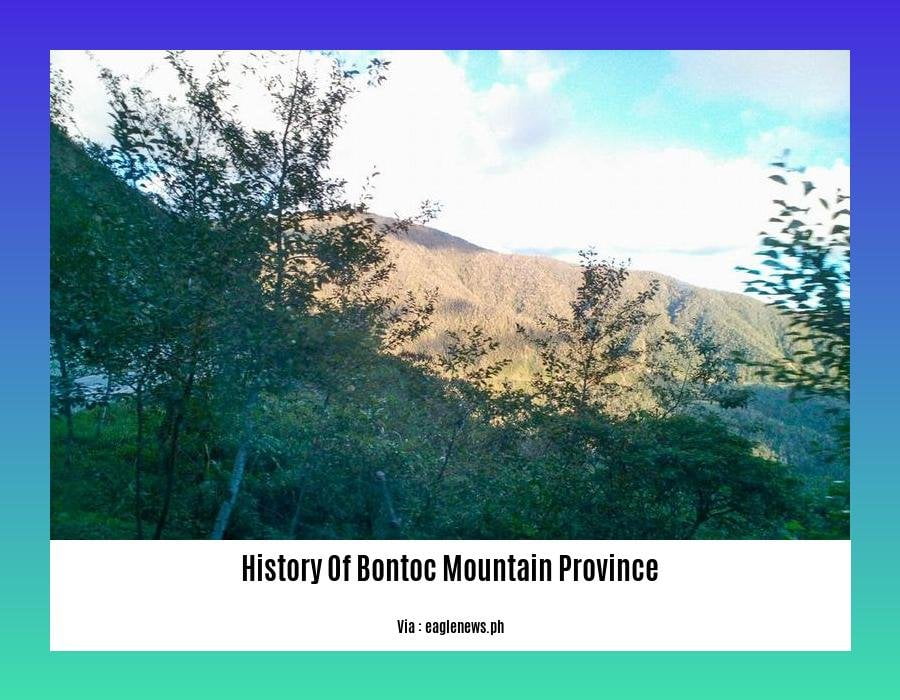Embark on a captivating journey through time as we delve into the rich history of Bontoc Mountain Province. Nestled amidst the rugged peaks of the Cordillera region, this enchanting land is a tapestry of diverse ethnic groups, each contributing to a vibrant cultural heritage. Join us as we uncover the stories of resilience, tradition, and innovation that have shaped this extraordinary province, leaving an indelible mark on the cultural landscape of the Philippines.
Key Takeaways:
Bontoc, the capital of Mountain Province, holds a population of approximately 24,000 people according to the 2020 census.
Known as the historical capital of the Cordillera region, Bontoc is famous for its annual Lang-ay Festival celebrating the indigenous culture of the Bontoc people.
The Bontoc tribe, indigenous to the region, historically engaged in tribal wars and practiced headhunting.
A unique ritual of passage into manhood involved headhunting, using the jaw of the hunted head as a handle for gongs.
Bontoc boasts the Alab petroglyphs, an ancient rock art site on the tentative list for UNESCO World Heritage status.
The local economy relies primarily on small trades and agriculture, while tourism is a growing sector due to the rich cultural heritage and natural beauty of the region.
The municipality of Bontoc is situated around 392 km (244 miles) from Manila, the capital of the Philippines.
History of Bontoc Mountain Province

Nestled in the heart of the Cordillera Central, the province of Mountain Province, Philippines, is renowned for its diverse ethnicities, rich customs, and breath-taking landscapes. Bontoc, its capital, stands out as a testament to the region’s cultural heritage.
The Bontoc People: A Legacy of Resilience
The Bontoc people, an indigenous tribe that has called this mountainous region home for centuries, have a captivating history. They were renowned for their intricate headhunting rituals, which served as a rite of passage into manhood. These headhunting expeditions were not merely acts of violence but were deeply intertwined with their beliefs and social structure. The jawbone of the hunted head would become the handle of a gong, a symbol of prestige and bravery.
Alab Petroglyphs: Whispers from the Past
Amidst the verdant slopes of Bontoc lies a hidden treasure – the Alab Petroglyphs, an ancient collection of rock carvings and inscriptions tentatively listed as a UNESCO World Heritage Site. These intricate etchings, believed to date back centuries, offer a glimpse into the lives and minds of the region’s earliest inhabitants. They depict scenes of daily life, rituals, and even warfare, providing invaluable insights into the province’s rich cultural heritage.
Lang-ay Festival: Celebrating Indigenous Roots
Every year, Bontoc bursts into a vibrant display of color and tradition during the Lang-ay Festival, a grand celebration that showcases the indigenous culture of the Bontoc people. This week-long event features parades, rituals, performances, and competitions that pay homage to the province’s ancestral roots. It’s a captivating spectacle that attracts visitors from far and wide, eager to witness the vibrant expressions of Bontoc’s cultural legacy.
Tourism: A Catalyst for Sustainable Development
In recent years, tourism has emerged as a significant industry in Bontoc, providing a sustainable economic engine while preserving the region’s cultural heritage. Visitors are drawn to the province’s breathtaking landscapes, fascinating history, and warm hospitality, contributing to the local economy and promoting cultural conservation.
A Journey Through Time
Delving into the history of Bontoc Mountain Province is a journey through time, where the past and present intertwine to create a vibrant tapestry of culture, tradition, and natural wonder. It’s a journey that will leave an indelible mark on your soul, inviting you to connect with the timeless spirit of this enchanting land.
Discover the fascinating history of Bohol, Philippines, by immersing yourself in the rich tapestry of its past- a tale of resilience, exploration, and cultural convergence- all waiting for you to uncover. history of bohol philippines
Unravel the untold stories of Cagayan Valley, a land that has borne witness to the ebbs and flows of history- from ancient civilizations to Spanish colonization and the struggle for independence. Embark on a journey through time and uncover the secrets that lie within. history of cagayan valley
Headhunting Tradition and the Role of Indigenous Law in the Bontoc Society

Understanding the headhunting tradition of the Bontoc people necessitates an in-depth examination of their indigenous law system. The Bontok, a group of fiercely loyal individuals known for their fierce loyalty, held a strong belief in the value of defending their territory and way of life. This belief system is intricately connected to their law, which served as the foundation for their social order and governed their conduct.
1. Historical Context
From the 16th to the 18th centuries, headhunting was practiced by the Bontok to show their strength and defend their territory. It was seen as a rite of passage into manhood and a way to avenge the deaths of loved ones. In addition to its role in maintaining social order, it also held spiritual significance.
2. Indigenous Law and Headhunting
Indigenous law in Bontoc society played a crucial role in regulating headhunting practices. It outlined the rules of engagement, the conditions under which headhunting was permitted, and the consequences for violating these rules. Customary laws governed the conduct of wars, the treatment of captives, and the distribution of war spoils. This legal framework ensured that headhunting was conducted in a controlled and orderly manner.
3. Revenge and Retribution
The primary motivation for headhunting among the Bontok was revenge for the death of a relative or community member killed by a rival tribe. According to Bontoc law, the aggrieved family had the right to seek retribution by taking the head of a member of the offending tribe. This retributive justice system aimed to deter future attacks and maintain a balance of power among the various tribes.
4. Symbolism and Prestige
In Bontoc culture, taking a head was seen as a symbol of courage, strength, and honor. Successful headhunters were highly respected within the community and often gained positions of leadership. The number of heads taken by a warrior was a measure of his bravery and status.
5. Decline of Headhunting
With the arrival of colonial powers and the introduction of Christianity in the late 19th century, the practice of headhunting gradually declined. The influence of Western culture, coupled with government efforts to suppress tribal warfare, led to the abandonment of this tradition. However, the legacy of headhunting continues to shape the cultural identity of the Bontoc people.
Key Takeaways:
The Bontok people practiced headhunting from the 16th to 18th centuries as a way to show their strength, defend their territory, and avenge their loved ones.
Indigenous law played a crucial role in regulating headhunting practices, outlining the rules of engagement, conditions, and consequences.
Headhunting was primarily motivated by revenge for the death of a relative or community member, and it served as a deterrent to future attacks.
Successful headhunters were highly respected within the community and often gained positions of leadership.
The practice of headhunting declined with the arrival of colonial powers and the introduction of Christianity.
Sources:
- Headhunting Rituals in Bontoc Society
- Bontoc People – Wikipedia
The Impact of Christianity, Education, and Modernization on the Bontoc Culture and Traditions
The Bontoc people, with their rich heritage and strong ties to their ancestral land, have undergone significant transformations due to the influences of Christianity, education, and modernization. These factors have left an indelible mark on their culture and traditions, shaping their way of life and beliefs.
Christianity and the Transformation of Beliefs
The arrival of Christianity in the Bontoc region brought about profound changes in their religious practices and beliefs. The introduction of the Christian faith led to the gradual decline of headhunting, a deeply ingrained tradition that had been a central part of their culture for centuries. Missionaries played a crucial role in spreading the Christian message, promoting peace and harmony among the different tribes.
Education and the Spread of Knowledge
The introduction of formal education in the Bontoc region opened up new avenues of knowledge and opportunities for the indigenous community. Schools and educational institutions provided the Bontoc people with access to modern education, allowing them to acquire new skills, knowledge, and insights into the wider world. Education played a significant role in empowering the Bontoc people, improving their literacy rates, and fostering a greater understanding of their own culture and traditions.
Modernization and the Changing Landscape
The advent of modernization brought with it a wave of technological advancements and infrastructural developments that transformed the Bontoc region. The construction of roads and bridges facilitated greater connectivity and access to the outside world, leading to increased trade and interaction with other communities. While modernization has brought many benefits, it has also posed challenges, as the Bontoc people strive to balance the preservation of their cultural identity with the demands of a rapidly changing world.
Despite the significant influences of Christianity, education, and modernization, the Bontoc people have remained resilient in preserving their cultural heritage. They continue to uphold their traditional practices, such as the Lang-ay Festival, a vibrant celebration that showcases their indigenous culture. The Bontoc people take pride in their distinct identity, maintaining a strong sense of community and preserving their rich traditions for future generations.
Key Takeaways:
- Christianity brought about the decline of headhunting, promoting peace and harmony among the Bontoc tribes.
- Education empowered the Bontoc people, providing access to knowledge and new opportunities.
- Modernization facilitated greater connectivity and economic opportunities but also posed challenges in preserving cultural identity.
- Despite these influences, the Bontoc people remain resilient, upholding their traditional practices and celebrating their cultural heritage.
Sources:
- Bontoc, Mountain Province: Culture, Heritage, Beauty | Igorotage
- The Bontoc People of the Philippines: History, Culture, and Traditions
Current efforts to promote ecotourism and sustainable development while preserving the unique cultural heritage of Bontoc Mountain Province
Tourism, with its power to boost economies and uplift communities, has emerged as a significant force in Bontoc Mountain Province. However, responsible tourism practices are imperative to ensure that the region’s rich cultural heritage remains intact while fostering sustainable development.
One notable initiative is the establishment of the Bontoc Ecotourism Society (BES), a community-based organization dedicated to promoting responsible tourism practices. BES works closely with local communities to develop ecotourism initiatives that respect and preserve the region’s cultural heritage.
Another key player is the Bontoc Municipal Government, which has implemented various policies and regulations to ensure sustainable tourism development. These include zoning regulations to protect sensitive cultural and natural areas, as well as guidelines for tour operators to minimize their environmental impact.
To further promote cultural preservation, the Bontoc Museum has been established as a repository for the region’s rich cultural heritage. The museum showcases artifacts, traditional costumes, and historical documents that provide visitors with an in-depth understanding of Bontoc culture.
In addition, various community-based tourism initiatives have been launched to provide visitors with authentic cultural experiences while generating income for local communities. These initiatives include guided tours led by local experts, homestays with indigenous families, and workshops on traditional crafts and skills.
By embracing these initiatives, Bontoc Mountain Province is successfully showcasing its unique cultural heritage while promoting sustainable tourism practices. This delicate balance ensures that the region’s rich traditions and natural beauty are preserved for generations to come.
Key Takeaways:
The Bontoc Ecotourism Society (BES) promotes responsible tourism practices through community-based initiatives.
The Bontoc Municipal Government has implemented policies and regulations for sustainable tourism development.
The Bontoc Museum serves as a repository for the region’s cultural heritage, providing visitors with an in-depth understanding of Bontoc culture.
Community-based tourism initiatives offer visitors authentic cultural experiences while generating income for local communities.
The province’s efforts to balance tourism development and cultural preservation ensure the sustainability of its rich heritage.
Sources:
Bontoc, Mountain Province: Preserving Cultural Heritage through Sustainable Tourism
Bontoc Museum: A Window into the Cultural Heritage of the Mountain Province
FAQ
Q1: What is the significance of the Lang-ay Festival in Bontoc Mountain Province?
A1: The Lang-ay Festival is an annual celebration that showcases the indigenous culture of the Bontoc people. It is a vibrant display of traditional dances, music, and rituals that attracts visitors from all over the world.
Q2: Why were the Bontoc people historically known for headhunting practices?
A2: Headhunting was a ritual of passage into manhood for the Bontoc people. They believed that taking a head would bring them strength, courage, and prestige. The hunted heads were often displayed as trophies on their houses.
Q3: What are the Alab petroglyphs and why are they significant?
A3: The Alab petroglyphs are ancient rock carvings and inscriptions found in Bontoc Mountain Province. They are believed to date back to the 13th century and are considered a valuable source of information about the history and culture of the Bontoc people. The petroglyphs depict various scenes, including hunting, warfare, and religious rituals.
Q4: How has the local economy of Bontoc evolved over time?
A4: The local economy of Bontoc has traditionally relied on small trades and agriculture. However, in recent years, tourism has emerged as a growing potential due to the region’s rich cultural heritage and natural landscapes.
Q5: What are some of the unique traditions and rituals that have been preserved by the Bontoc people?
A5: The Bontoc people have preserved numerous traditions and rituals that are intricately interwoven into their way of life. These include the Lang-ay Festival, the headhunting ritual, and the Alab petroglyphs. They also have a strong tradition of music and dance, which is often performed during ceremonies and celebrations.
- Georgia Platform: A Southern Strategy, 1850s - March 31, 2025
- How many weeks is 40 days: Quick Conversion Guide for Accurate Results - March 31, 2025
- How many feet is 300 meters? 984 Feet: Understand Length Conversions Easily - March 31, 2025
















